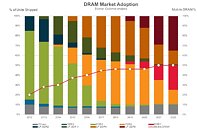Jul 24th, 2025 00:38 CDT
change timezone
Latest GPU Drivers
New Forum Posts
- Dell Workstation Owners Club (3323)
- 14900k high voltage (32)
- Forum Search Engine Upgraded (5)
- Unknown Subvendor in GPU-Z (8)
- Crash at upgrade to 2.67 (10)
- Questionable quality future game releases being considered (1)
- Your PC ATM (35534)
- Frametime spikes and stuttering after switching to AMD CPU? (577)
- Will you buy a RTX 5090? (652)
- Turbo Boost with no softwares? (0)
Popular Reviews
- Noctua NF-A12x25 G2 PWM Fan Review
- MSI MPG B850I Edge Ti Wi-Fi Review
- Cougar OmnyX Review
- Thermal Grizzly WireView Pro Review
- TerraMaster F4-424 Max Review - The fastest NAS we've tested so far
- UPERFECT UMax 24 Review
- Razer Blade 16 (2025) Review - Thin, Light, Punchy, and Efficient
- Upcoming Hardware Launches 2025 (Updated May 2025)
- Sapphire Radeon RX 9060 XT Pulse OC 16 GB Review - An Excellent Choice
- AMD Ryzen 7 9800X3D Review - The Best Gaming Processor
TPU on YouTube
Controversial News Posts
- Some Intel Nova Lake CPUs Rumored to Challenge AMD's 3D V-Cache in Desktop Gaming (140)
- AMD Radeon RX 9070 XT Gains 9% Performance at 1440p with Latest Driver, Beats RTX 5070 Ti (131)
- NVIDIA Launches GeForce RTX 5050 for Desktops and Laptops, Starts at $249 (127)
- NVIDIA GeForce RTX 5080 SUPER Could Feature 24 GB Memory, Increased Power Limits (115)
- AMD's Upcoming UDNA / RDNA 5 GPU Could Feature 96 CUs and 384-bit Memory Bus (113)
- NVIDIA DLSS Transformer Cuts VRAM Usage by 20% (99)
- AMD Sampling Next-Gen Ryzen Desktop "Medusa Ridge," Sees Incremental IPC Upgrade, New cIOD (97)
- NVIDIA Becomes First Company Ever to Hit $4 Trillion Market-Cap (94)
Wednesday, October 17th 2018

Cadence, Micron Update on DDR5: Still On Track, 1.36x Performance Increase Over DDR4 at Same Data Rate
DDR5 will be the next step in DDR5 memory tech, again bringing increased transfer speeds over the previous JEDEC (the standards body responsible for the DDR specifications) specification. The new memory technology will also bring the customary reductions in operating voltage - the new version will push the 64-bit link down to 1.1V and burst lengths to 16 bits from 1.2V and 8 bits. In addition, DDR5 lets voltage regulators ride on the memory card rather than the motherboard. CPU vendors are also expected to expand the number of DDR channels on their processors from 12 to 16, which could drive main memory sizes to 128 GB from 64 GB today.
DDR5 is being developed with particular attention to the professional environment, where ever-increasingly gargantuan amounts of addressable memory are required. One of the guiding principles over DDR5's development is a density increase (to allow 16 Gbit chips) that would allow for larger volumes of memory (and thus data processing) in the environments that need that. Reduced power consumption also plays a role here, but all of this will have a cost: latency. For end-users, though, this increased latency will be offset by the usual suspects (DDR memory companies such as Crucial, Corsair, just to name some started with the letter C) in tighter timings and increased operating frequencies. JEDEC's specification for DDR5 is set at 4800 MT/s, but it's expected the memory tech will scale to 6400 MT/s, and you know overclocking and performance-focused companies will walk all over the standard.Some other, performance and stability-centric features of DDR5 include use two independent 32/40-bit channels per module (without/or with ECC); improved command bus efficiency, with per-channel 7-bit Address (Add)/Command (Cmd) buses, better refresh schemes, and an increased bank group for additional performance. There will also be support for on-die termination (a particularly important feature for Ryzen's memory stability and overclocking prowess), which enables cleaner signals with less electrical disruption and feedback, with improved stability at higher data rates. Furthermore, high-end DDR5 DIMMs will have their own voltage regulators and PMICs, thus improving power delivery and other variables.Cadence says that while comparing DDR4 3200 vs DDR5 3200, there is already an increase in bandwidth of 1.36X - yes, at the same data rate. Add in the frequency increase (and consider the density increase as well), and there's a 1.87x increase in performance when comparing DDR4 3200 to DDR5 4800. Ramp for server/datacenter and other professional environments will start in 2019, with the technology entering the consumer market in 2020 - interestingly, the same longevity AMD themselves gave their Zen architecture.
Sources:
Cadence, via AnandTech
DDR5 is being developed with particular attention to the professional environment, where ever-increasingly gargantuan amounts of addressable memory are required. One of the guiding principles over DDR5's development is a density increase (to allow 16 Gbit chips) that would allow for larger volumes of memory (and thus data processing) in the environments that need that. Reduced power consumption also plays a role here, but all of this will have a cost: latency. For end-users, though, this increased latency will be offset by the usual suspects (DDR memory companies such as Crucial, Corsair, just to name some started with the letter C) in tighter timings and increased operating frequencies. JEDEC's specification for DDR5 is set at 4800 MT/s, but it's expected the memory tech will scale to 6400 MT/s, and you know overclocking and performance-focused companies will walk all over the standard.Some other, performance and stability-centric features of DDR5 include use two independent 32/40-bit channels per module (without/or with ECC); improved command bus efficiency, with per-channel 7-bit Address (Add)/Command (Cmd) buses, better refresh schemes, and an increased bank group for additional performance. There will also be support for on-die termination (a particularly important feature for Ryzen's memory stability and overclocking prowess), which enables cleaner signals with less electrical disruption and feedback, with improved stability at higher data rates. Furthermore, high-end DDR5 DIMMs will have their own voltage regulators and PMICs, thus improving power delivery and other variables.Cadence says that while comparing DDR4 3200 vs DDR5 3200, there is already an increase in bandwidth of 1.36X - yes, at the same data rate. Add in the frequency increase (and consider the density increase as well), and there's a 1.87x increase in performance when comparing DDR4 3200 to DDR5 4800. Ramp for server/datacenter and other professional environments will start in 2019, with the technology entering the consumer market in 2020 - interestingly, the same longevity AMD themselves gave their Zen architecture.
Jul 24th, 2025 00:38 CDT
change timezone
Latest GPU Drivers
New Forum Posts
- Dell Workstation Owners Club (3323)
- 14900k high voltage (32)
- Forum Search Engine Upgraded (5)
- Unknown Subvendor in GPU-Z (8)
- Crash at upgrade to 2.67 (10)
- Questionable quality future game releases being considered (1)
- Your PC ATM (35534)
- Frametime spikes and stuttering after switching to AMD CPU? (577)
- Will you buy a RTX 5090? (652)
- Turbo Boost with no softwares? (0)
Popular Reviews
- Noctua NF-A12x25 G2 PWM Fan Review
- MSI MPG B850I Edge Ti Wi-Fi Review
- Cougar OmnyX Review
- Thermal Grizzly WireView Pro Review
- TerraMaster F4-424 Max Review - The fastest NAS we've tested so far
- UPERFECT UMax 24 Review
- Razer Blade 16 (2025) Review - Thin, Light, Punchy, and Efficient
- Upcoming Hardware Launches 2025 (Updated May 2025)
- Sapphire Radeon RX 9060 XT Pulse OC 16 GB Review - An Excellent Choice
- AMD Ryzen 7 9800X3D Review - The Best Gaming Processor
TPU on YouTube
Controversial News Posts
- Some Intel Nova Lake CPUs Rumored to Challenge AMD's 3D V-Cache in Desktop Gaming (140)
- AMD Radeon RX 9070 XT Gains 9% Performance at 1440p with Latest Driver, Beats RTX 5070 Ti (131)
- NVIDIA Launches GeForce RTX 5050 for Desktops and Laptops, Starts at $249 (127)
- NVIDIA GeForce RTX 5080 SUPER Could Feature 24 GB Memory, Increased Power Limits (115)
- AMD's Upcoming UDNA / RDNA 5 GPU Could Feature 96 CUs and 384-bit Memory Bus (113)
- NVIDIA DLSS Transformer Cuts VRAM Usage by 20% (99)
- AMD Sampling Next-Gen Ryzen Desktop "Medusa Ridge," Sees Incremental IPC Upgrade, New cIOD (97)
- NVIDIA Becomes First Company Ever to Hit $4 Trillion Market-Cap (94)



32 Comments on Cadence, Micron Update on DDR5: Still On Track, 1.36x Performance Increase Over DDR4 at Same Data Rate
Dual channel is 128-bit IIRC. GDDR6 needs large channel widths to work at great performance in a video card. It would probably suffer being used as main memory with a dual channel 128-bit controller, you'd need at least quad channel.
Desktop CPUs access memory in 64 byte blocks scattered across the address space, so their memory is latency optimized.
GPUs access memory more through continuous streams of data, which is why GDDR is bandwidth optimized.
First there is not enough ddr6 production to accommodate it, second ,jedec standards for memory are what enable Any buyer to buy ddr4 and have it work.
With new memory types, they're still in the special stage where the interconnection standards have not been set or finalized fully so only companies with the r and d time and knowledge are able to use them in their products.
The Subor uses ddr5 ,3 nah 5 years after ddr4 introduction, and after bigdog sony ,ddr4 is well known and qualified at this point.
Read about Quad data rate
The image in the article is a visualization of these signals:
I have 6 addon cards that use DDR1 RAM also. :P
I'm sure this is explained in the proposed spec somewhere, but since (shockingly) I don't have the time to scour the spec for one detail, I was hoping someone more knowledgeable was lurking these forums instead.
I mean, we've been through this more times than I care to remember. Whether the memory controller was on the motherboard or in the CPU, we never had to deal will significant price increases.
DDR4 also sucked on launch.